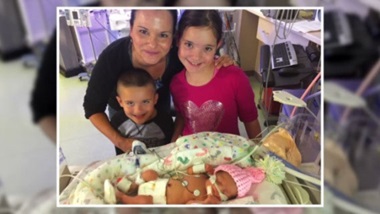Twin Reversed Arterial Perfusion (TRAP)
What is twin reversed arterial perfusion?
Twin reversed arterial perfusion (TRAP sequence) is a rare condition of monochorionic twin pregnancies. It arises when the cardiac system of one twin does the work of supplying blood for both twins. The twin supplying the blood is known as the "pump twin" and develops normally in the womb. However, the increased pumping of the heart puts this twin at risk for cardiac failure. The other twin — known as the "acardiac twin" — lacks a heart or has one that is not fully formed. It usually has a poorly developed body and may also be missing a head, limbs and torso.
Monochorionic Twin Pregnancies
Monochorionic twins are identical twins who share a placenta (afterbirth) and a network of blood vessels that supply oxygen and nutrients essential for development in the womb. TRAP occurs in about 1 percent of monochorionic pregnancies or 1 in every 35,000 pregnancies.
What causes twin reversed arterial perfusion?
With TRAP, it is believed that very early in pregnancy, a dramatic, ongoing fluctuation of blood pressure and blood flow may interfere with the development of the heart in the acardiac twin. Though the pump twin’s heart may go on to develop properly, the vessel connections between the twins can create problems. In cases of TRAP, the blood from the healthy pump twin flows backwards from the placenta into the unhealthy acardiac twin. Because the acardiac twin lacks a functional heart, it is unable to reciprocate and provide the forward flow of blood found in a normal fetal circulatory system.
Because the acardiac twin fails to fully develop vital organs, survival outside of the womb is not possible. In fact, the acardiac twin is technically not a fetus, but a mass of tissue that grows because of the blood flowing from the pump twin. Fetal interventions focus on monitoring the heart health of the pump twin and include procedures to stop blood flow to the acardiac twin.
What are the risk factors of twin reversed arterial perfusion?
There are no known risk factors associated with TRAP. It is an indiscriminate condition, occurring at random in monochorionic pregnancies.
Twin Reversed Arterial Perfusion Diagnosis
TRAP may be suspected based on the results of a prenatal ultrasound. The first step in confirming a diagnosis is establishing a monochorionic twin pregnancy. Ultrasound results may show one normally developing fetus and an atypical mass with abnormal cardiac activity. To confirm the diagnosis, the blood flow pattern must be studied using Doppler ultrasound. Advances in 3-D and 4-D ultrasound now allow maternal-fetal medicine specialists to diagnose TRAP sequence as early as 11 weeks of gestation.
The Johns Hopkins Center for Fetal Therapy

Our team partners with patients and their families to deliver personalized care for a wide range of complex prenatal conditions.
Twin Reversed Arterial Perfusion Treatment
The prognosis of a TRAP sequence depends on the strain the increased cardiac effort places on the heart of the pump twin. If given enough nutrient support, the body of the acardiac twin can grow at a similar rate as that of the pump twin. When this occurs, the risk of heart failure in the pump twin increases.
If it is determined that the healthy pump twin is at an increased risk for heart failure, fetal surgery may be recommended to close off the blood vessels feeding the acardiac twin. The following procedures have been used to successfully treat TRAP sequence:
-
Radiofrequency ablation (RFA) may be recommended in cases where the gestational age is greater than 16 weeks. This procedure involves the insertion of a small needle into the uterus. The needle contains several sharp prongs that disperse heat energy of radio frequency. The heat energy is used to seal the feeding vessels supplying blood to the acardiac twin at the base of its umbilical cord.
-
Bipolar coagulation: In cases where the gestational age is under 16 weeks, bipolar coagulation may be recommended. This procedure seals off a portion of the acardiac twin’s umbilical cord near the placenta.
Any prenatal fetal procedure presents risks to both mom and baby. Following cord coagulation, the portion of the placenta no longer receiving blood supply from the circulation of the demised twin undergoes degenerative changes that increase the risk of preterm labor.
In patients who do not experience complications, the healthy twin has more than a 90 percent chance of a good outcome. The vestiges of the acardiac can remain in the womb until delivery. Most women go on to have a normal delivery and a healthy baby.






